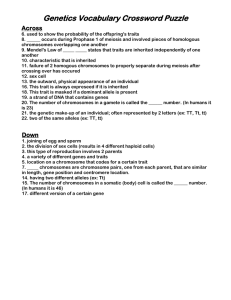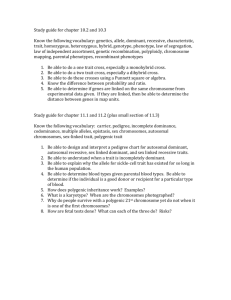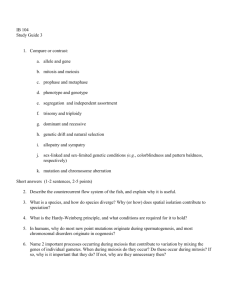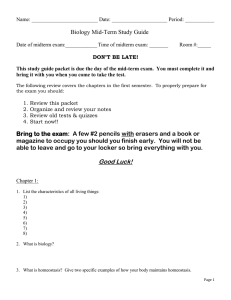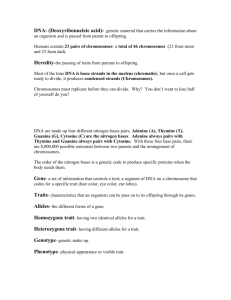Mid-term exam review - Angwenyi Education Center
advertisement
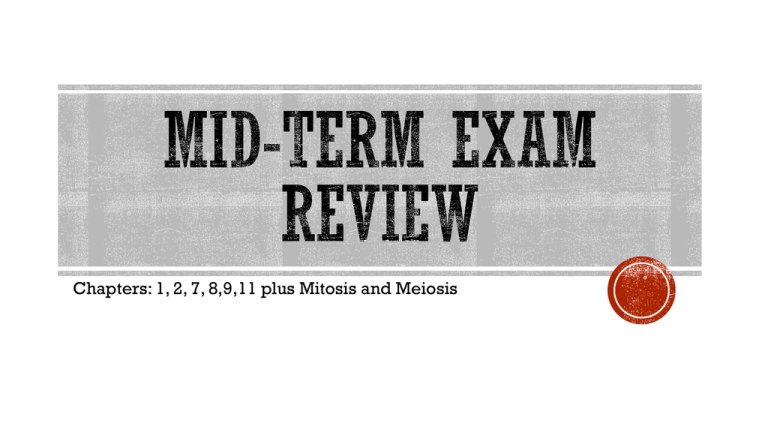
Chapters: 1, 2, 7, 8,9,11 plus Mitosis and Meiosis Section I: 100 Multiple choice questions (1Point Each). Section II: 5 Short Answer questions with sub-sections: questions require fill in or short explanations of biology concepts from the chapters specified above (40 Points). Characteristics of living things: 1. All living things are made of cells. 2. All living things evolve. 3. All living things use and obtain energy- metabolism. 4. All living things reproduce. 5. Genetics. 6. Growth. 7. Homeostasis. 8. Respond to environment- stimulus 2. What is Biology? The study of life. 3. What is Homeostasis? Maintaining a stable internal environment. 4. Define sexual and asexual reproduction. Sexual reproduction- involves two organisms and exchange of genetic material. Asexual reproduction: only one organism and no exchange of genetic material Question #5: Experimental Design A. Which type of soil would rose bushes grow tall? B. Type of soil is the manipulated variable ( independent variable). C. Height of rose bush is the responding variable ( dependent variable). D. Controlled variables: size of the pots, amount of water, light and temperature. Question # 6: Experimental Design A. How does temperature affect the newly discovered fish? B. Temperature. C. Fish thriving. D. Number of fish, size of tank, number of days. 1. Protons ( +, nucleus); Electrons ( -, orbit of nucleus), Neutron ( 0, nucleus). 2. Isotopes are atoms of the same element that differ in the number of neutrons. 3. Atomic number refers to the number of protons , and atomic mass refers to the number of neutrons plus protons. In a neutral atom # of protons = # of electrons. 4. pH scale measures the amount of acid or base in a solution. It ranges from 1-14. Substances with a pH below 7 are acids, 7 is neutral and above 7 is base. 1 is a strong acid and 14 is a strong base. 5. A catalyst is a substance that speeds up the rate of a chemical reaction. 6. Factors affecting enzyme catalyzed reactions include: temperature, pH, inhibitors, concentration. 7. Activation energy: refers to amount of energy needed to start a chemical reaction. Enzymes affect reactions by lowering the activation energy needed to start a reaction. 8. Parts of a chemical reaction: Reactants, Direction of the reaction and Products. 9. Suspension: undissolved particles in a solution. 1. Organic compounds are made of carbon, hydrogen and oxygen. 2. Fill out the Table Organic Compound Monomer Examples Primary Function Protein Amino Acids Enzymes Structures, regulatory Carbohydrate Monosaccharides Glucose, Starch Energy Source Lipid Glycerol + Fatty Acids Oils, fats, waxes Energy Storage Nucleic Acid Nucleotides DNA, RNA Genetic information #3. An Enzyme is a biological catalyst that is usually protein in nature that speeds up the rate of chemical reactions. #4. Lock and Key Model of Enzyme activity 5. Label statements True or False A. True- Enzymes are types of proteins. B. False- Enzymes slow down rate of chemical reactions. C. True- Each enzyme is specific, it only works on one type of substance. D. True- Enzymes become denatured at high temperatures. E. True- Enzymes work best at a narrow pH range. F. False- Enzymes cannot be re-used. G. True- Proteins are made of amino acids. H. False- Proteins are made in the mitochondria. I. True- Proteins make up our blood, hair, skin, heart, muscles, and bones. #6. Use graphs A. No, enzyme 1 does not function at pH 5.5 B. 6.5 is the best pH for enzyme 2 C. Enzyme 3 has the broadest pH range. #1. A cell is the basic unit of structure and function. #2. 3 parts of a cell theory are: A. All living things are made of cells. B. Cells come from pre-existing cells. C. A cell is the unit of structure and function. #3. A prokaryotic cell has no nucleus , a eukaryotic cell has a nuclear and membrane bound organelles such as ER, Mitochondria, Lysosomes, etc. #4. Differences between a plant cell and animal cell. Animal Cell Plant Cell • No cell wall. • No chloroplast. • Small vacuole • Has a cell wall • Has a chloroplast. • Large vacuole. #5. Matching organelles with function. A. Where proteins are made- Ribosome. B. Site of photosynthesis in plants- Chloroplasts. C. Transport system of a cell- Endoplasmic reticulum. D. Provide support and protection for pant cell- Cell wall. E. Storage area of the cell- Vacuole. F. Powerhouse of the cell- mitochondria. G. H. Control center of the cell- Nucleus. H. I. Selectively permeable, controls what goes in and out- Cell membrane. #6. Functions of cell structures: Golgi Apparatus: packages materials within the cell. Lysosome: digests and removes waste. Cystoskeleton: provides support and structure to the cell. 7. Label the diagram Animal Cell Plant Cell A. Rough Endoplasmic Reticulum. A. Cell Wall. B. Cytoplasm. B. Nucleus. C. Smooth ER. C. Cell membrane. D. Nucleolus. D. ER E. Nucleus. E. Chloroplast. F. Mitochondria. F. Vacuole. G. Golgi apparatus H. Ribosome #8. Selectively permeable means that only certain things are allowed into and out of the cell. #9. Cell membrane is made up of a lipid bilayer and protein channels. The lipid bilayer consists of a phosphate head and lipid tail. The phosphate head is hydrophilic while the tail is hydrophobic. #10. The function of the cell membrane is to regulate what goes into and out of the cell thereby protecting the cell. #11. Diffusion is the movement of molecules from regions of high concentration to regions of low concentration. #12. Equilibrium is reached when the rate of movement of materials into and out of the cell is equal. #13. Osmosis is the diffusion of water molecules through a semi-permeable membrane. #14. Define the terms: Isotonic solution: a solution that has an equal salt concentration as the inside of the cell. E.g. 50% ( outside) : 50% ( Inside) Hypotonic solution: a solution that has a low salt concentration than the inside of a cell. A cell placed in a hypotonic solution will swell and burst over time. Hypertonic solution: a solution that has a high salt concentration than the inside of a cell. A cell placed in a hypertonic solution shrinks. #15. Active transport requires energy to move materials into or out of a cell. #16. Active transport requires protein channels to move large materials across the membrane. Energy is used to move molecules across the membrane. #17. Endocytosis is a type of active transport in which molecules are moved into the cell. Exocytosis is a type of active transport in which molecules are moved out of the cell. #18. Diffusion is a passive process which means no energy is required whereas active transport require energy to move materials into and out of the cell. 1. Photosynthesis is the process by which autotrophs such as plants convert carbon dioxide and water into food molecules using light energy which is trapped using special pigments called chlorophyll. 2. Equation for photosynthesis #3. Photosynthesis occurs in the chloroplast. #4. Autotrophs such as plants and bacteria. #5. ATP is the most important energy molecule. #6. ATP Molecule consists of Adenosine triphosphate. #7. Two types fermentation are: Alcoholic and Lactic Acid Fermentation. In alcoholic fermentation yeast cells break down sugar to release ATP, carbon dioxide and alcohol are formed as by-products. In muscle cells, in the absence of oxygen, sugar is broken down, and lactic acid is formed. $8. Cellular respiration in the presence releases 36 ATP while fermentation releases a net of 2 ATP. #9. #10. Cellular respiration occurs in the mitochondria. #11. All living organisms carry out cellular respiration. Homozygous: contain the same alleles e.g TT, tt Heterozygous: contain a dominant and a recessive gene: Tt Dominant: a trait that is always expressed. Recessive: a trait that is only expressed in the absence of a dominant gene. Genotype: the genetic make up of a trait. Phenotype: the physical appearance or what is observed. Hybrid: a trait that is produced as a result of pure breeding between a dominant and a recessive trait. Pure breed: consists of the homozygous alleles e.g, TT or tt Allele: alternate form of a gene #2: The principle of dominance states that a dominant trait is always expressed over a recessive trait. #3. Segregation occurs during meiosis when alleles assort independently to form sex cells ( sperm or egg). #4. Independent assortment: states that alleles separate independently during meiosis. #5. Probability predicts possible outcomes in a class. There is always a ½ chance that a trait will be passed on if there are two possible outcomes. #6. Gene: A portion of a DNA molecule that serves as the basic unit of heredity. Genes are found in DNA which is carried in the chromosomes. #7. Monohybrid cross involves one single factor. Dihybrid cross involves two factors. #8. Codominance occurs where two dominant genes are present and expressed. This is results into patches or speckles like in red/white specks in chicken. #9. Incomplete dominance occurs when two traits are not completely dominant over each other resulting in an intermediate trait. Red rose flower and white red rose flower when crossed forms pink flowers. #10. Multiple alleles: occurs when three or more alternative or allelic forms of a gene are present for a single trait, only two of which can exist in any normal, diploid individual. #11. Gregor Mendel: studied pea plants and provided explanation of how genes are passed on from parents to off-springs ( heredity). #12. Diploid number means that two sets of chromosomes are present. 46 Chromosomes is diploid number and 23 chromosomes is haploid number. #13: Haploid number means half the number of chromosomes and this is found in sex cells. A human egg will 23 chromosomes and a sperm will have 23 chromosomes. #14. Gametes are sex cells such as a sperm or egg. #15. Crossing over: This is the exchange of genetic material between homologous chromosomes that occurs during meiosis and contributes to genetic variability. #16. Mitosis is the process by cells divide in order to grow and occurs in all cells whereas meiosis is the process by which the number (diploid) of chromosomes is halved ( haploid), and occurs in sex cells only. Punnett square of Homozygous tall plant crossed with homozygous short plant where tall is dominant: a. T T t Tt Tt t Tt Tt Genotypes: 100 % Tt and 100 % Tall phenotype . Two heterozygous tall plants crossed: T t T TT Tt t Tt tt b. Genotype: TT: Tt: tt which is 1:2:1 ratio Phenotype: 3 Tall and 1 short which is 3:1 ratio c. If two plants are crossed, it is possible for all to be short if the genotypes were heterozygous as there is 25% chance of obtaining a short plant. There is more chance of getting tall plants (75%) but because this is all based on chance, all plants can be short or tall, just like a chance of a child being a female or male, a family can have all boys or girls.

